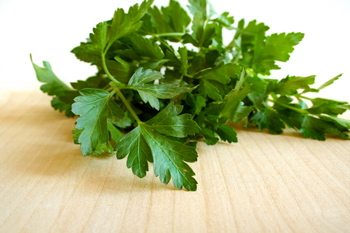Italian Parsley
 |
Mix chopped parsley with lemon zest and garlic coves to make gremolata, a traditional Italian condiment that brings fresh, lively flavor to meats, poultry, fish and vegetables. |
See also parsley.
This popular herb variety has flat, dark green leaves, succulent stems and a strong, slightly peppery taste. Like its curly-leafed relative, Italian parsley is commonly used as a flavoring or garnish.
History
Parsley has been grown all over the world for thousands of years, but Sardinia claims its birthplace. Before Sardinia became a part of Italy, the Mediterranean island featured parsley on its currency.
Buying Tips
Choose bunches with bright green leaves and no signs of wilting.
Storage Tips
Wash fresh parsley and thoroughly pat dry. Wrap loosely with paper towels, place in a plastic storage bag and refrigerate for up to one week. Alternatively, trim the stems and place the parsley in a glass of cold water with a pinch of sugar (like a bouquet). Loosely cover with a plastic bag secured with a rubber band. Change the water every two days.
Usage Tips
• To use parsley, simply cut the stems of an entire bunch as close to the leaves as possible. The stems of Italian parsley are actually quite tender, so they won't be noticed if mixed into your recipes.
• Before chopping, make sure the leaves are thoroughly dry or they'll just stick to your knife.
• For easy chopping, hold parsley sprigs together and snip with kitchen shears.
Nutrition Notes
Parsley is rich in calcium, iron, manganese and vitamins A and C.
Try one of our favorite Italian parsley recipes:
Grilled Tuna with Black-Eye Pea Salad
Mediterranean Chicken
Jerk Chicken Thighs on Sweet Potato Pancakes





